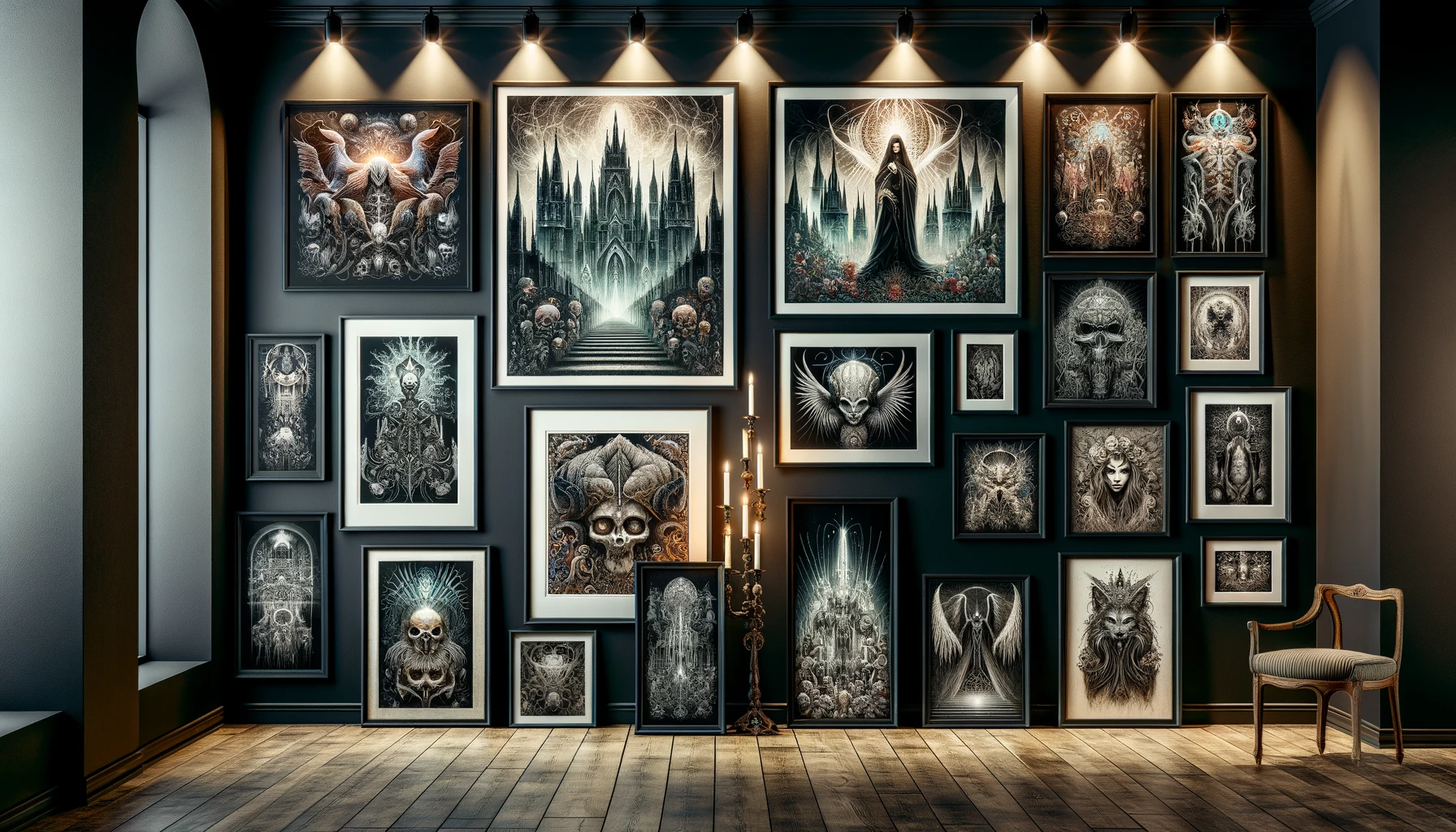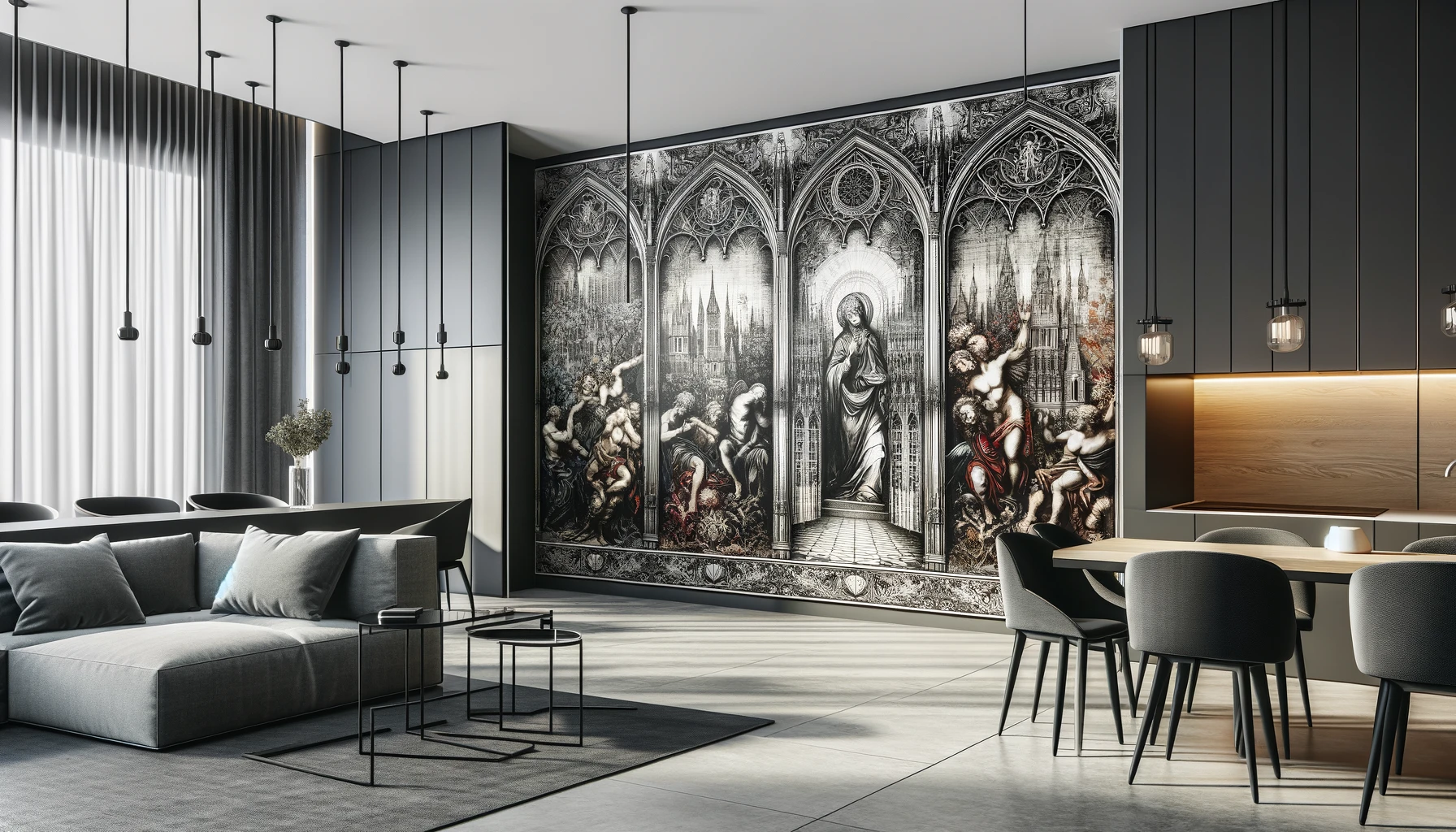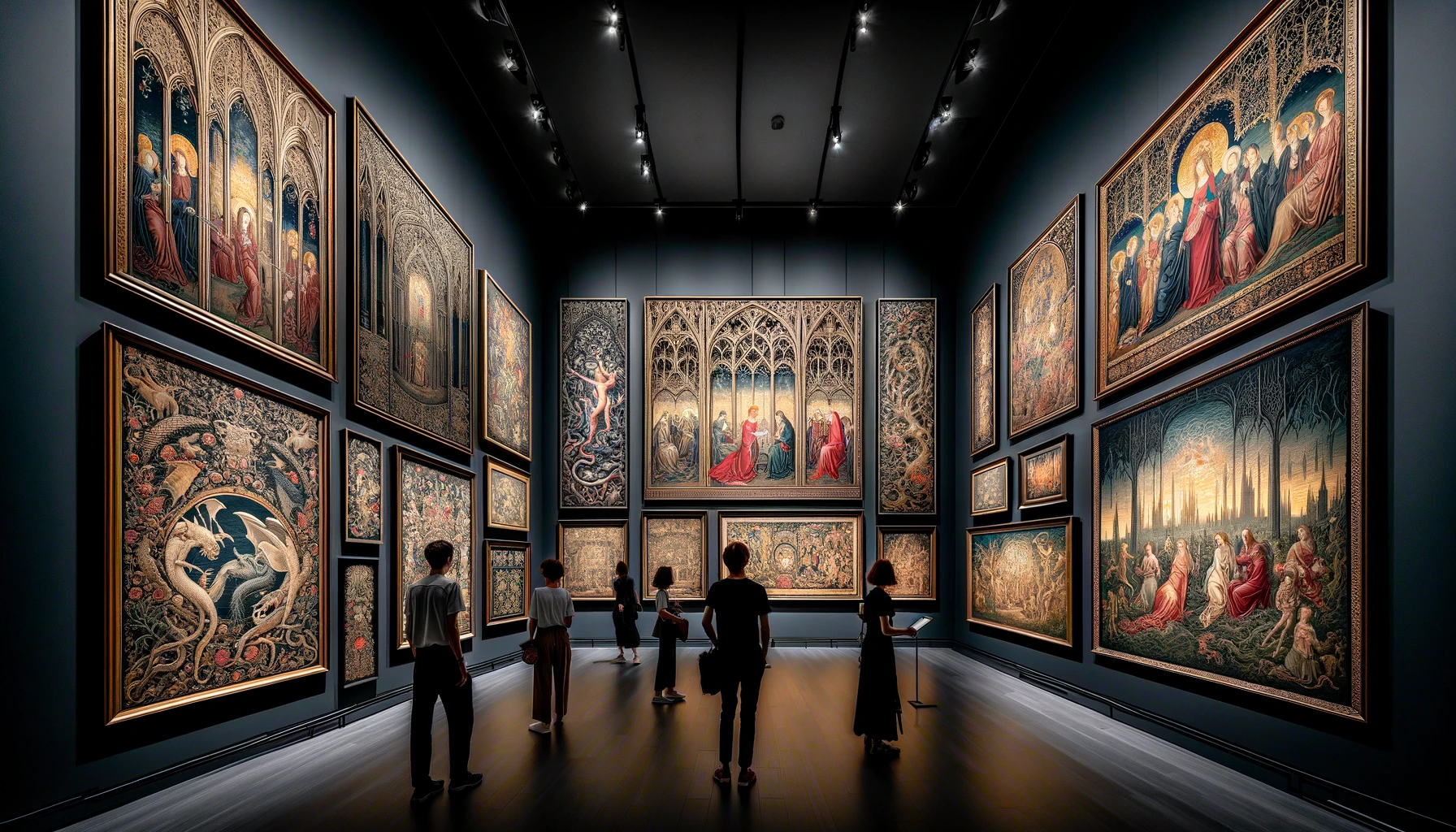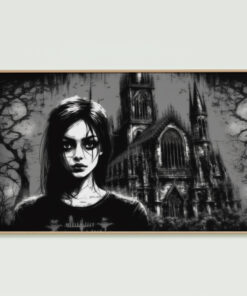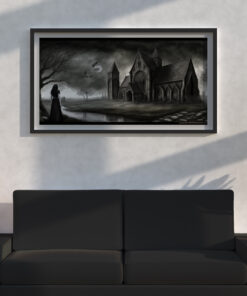
Timeless Gothic : The Wall as Canvas
Gothic wall art traces its origins back to the medieval period in Europe, a time when art and architecture underwent a profound transformation. This era, spanning from the 12th to the 16th centuries, witnessed the rise of Gothic architecture – characterized by its pointed arches, ribbed vaults, and flying buttresses. These architectural elements were not only structural innovations but also served as a canvas for artistic expression, adorned with sculptures, frescoes, and stained glass that told biblical stories and depicted saints.
Origins in Medieval Europe
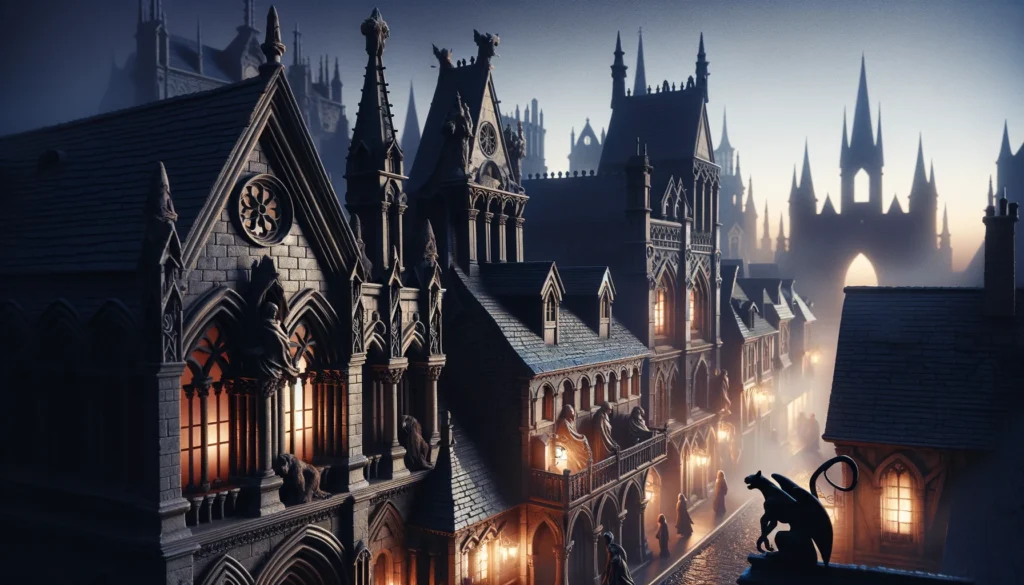
The genesis of Gothic art is closely linked to the development of Gothic architecture, with the first Gothic buildings appearing in France in the early 12th century. This style quickly spread across Europe, revolutionizing the construction of cathedrals and churches. The walls of these structures became canvases for artisans and artists, who embellished them with religious iconography and narratives, bringing light and color into sacred spaces.
Evolution to Wall Art
As Gothic architecture flourished, so did the art that adorned its walls. Initially, the focus was on religious themes, designed to educate and inspire awe among the faithful. However, over time, Gothic wall art began to evolve, incorporating secular themes and exploring more personal, introspective subjects. This transition marked the beginning of wall art’s journey from public and sacred spaces to private ones, where it served not only a decorative purpose but also a medium for personal expression and storytelling.
Defining Characteristics of Gothic Wall Art
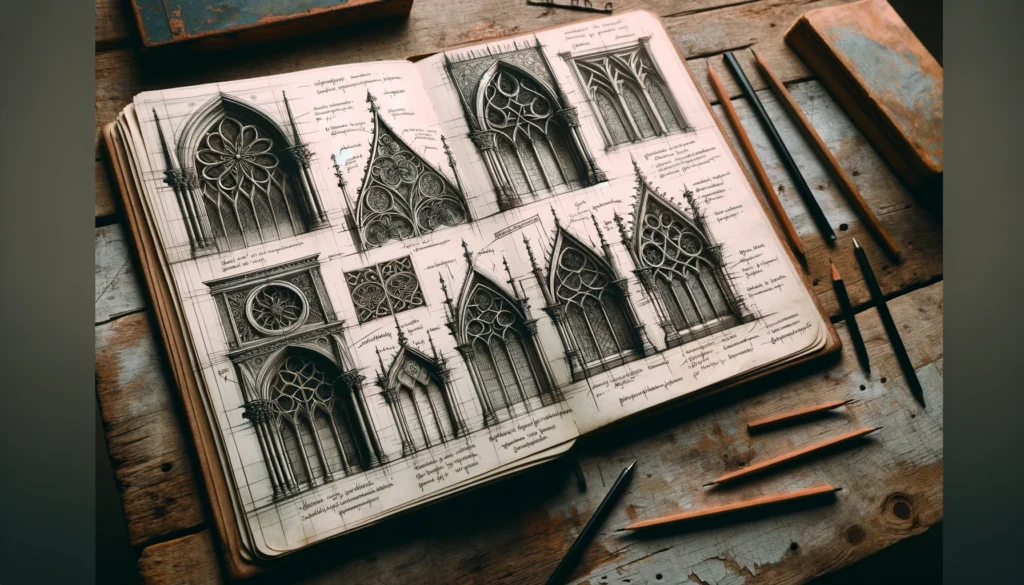
Gothic wall art is distinguished by several key characteristics that set it apart from other artistic movements. These include a profound sense of dramatic intensity, a deep engagement with symbolic imagery, and a unique approach to light and color. Together, these elements create a distinctive aesthetic that captures the Gothic spirit.
Key Elements
- Dramatic Intensity: Gothic art is renowned for its emotional power and dramatic visuals. Artworks often depict scenes of religious ecstasy, martyrdom, and the macabre, underscoring the period’s preoccupation with life, death, and the divine.
- Symbolic Imagery: Symbolism is rampant in Gothic art, with common motifs including the rose window (representing the universe), the gargoyle (intended to ward off evil spirits), and the labyrinth (symbolizing the journey of faith). These symbols were not mere decorations but conveyed complex theological and philosophical ideas.
- Light and Color: The use of light and color in Gothic wall art is revolutionary. Stained glass windows, for instance, filled cathedrals with vibrant light, illustrating biblical stories in vivid hues. On canvas and wood, artists employed rich colors and contrasting light and shadow to create depth and emphasize the emotional impact of their subjects.
Symbolism
The Gothic era was a time of deep religious devotion, and this is reflected in the symbolism pervasive in its art. Every motif, from the intricate tracery of a cathedral’s window to the smallest detail in a fresco, was imbued with meaning. For instance, the ivy represents immortality and eternal life, while dragons symbolize sin and the challenges to faith. These symbols served as a visual language, communicating messages of faith, morality, and the cosmic order to a largely illiterate populace.
By focusing on the historical roots and defining characteristics of Gothic wall art, we gain a deeper understanding of its significance and the enduring legacy it leaves on contemporary art and culture. This exploration reveals not only the aesthetic beauty of Gothic art but also its capacity to convey complex ideas and emotions, bridging the past with the present.
Delve into the realm of mystery and refinement with our handpicked collection at our Gothic Wall Art showcase
Iconic Motifs and Symbols in Gothic Art
Gothic art is rich in motifs and symbols, each carrying deep meanings and reflecting the era’s complex socio-religious context. This section delves into the iconic motifs that are synonymous with Gothic art, unraveling their symbolism and significance.
Common Motifs
- Arches and Gargoyles: The pointed arch is a hallmark of Gothic architecture, symbolizing the heavens and the aspiration towards God. Gargoyles, often misunderstood as mere decorative elements, served a dual purpose – to channel rainwater away from the building and to ward off evil spirits, representing protection and vigilance.
- Religious Iconography: Scenes from the Bible, depictions of saints, and the Virgin Mary were predominant, aimed at conveying religious narratives to the populace. These images served as visual sermons, educating and reinforcing faith among the viewers.
Symbolism and Meanings
- The Rose Window: Often found in cathedrals, the rose window is a circular stained glass window whose intricate design and vibrant colors symbolize the universe and divine light. It’s a representation of the complexity and beauty of creation, inviting contemplation and spiritual reflection.
- The Labyrinth: Found on the floors of many Gothic cathedrals, the labyrinth represents the journey of life, with its complicated path symbolizing the pilgrim’s path to salvation and enlightenment. It invites meditation and personal reflection on one’s spiritual journey.
Materials and Techniques of the Masters
-
Gothic Wall Art Catacombs of Paris Enigma
-
Gothic Wall Art Full Moon Witch
-
Gothic Wall Art Haunted Tower of London
The creation of Gothic wall art involved a variety of materials and techniques, reflecting the artists’ and craftsmen’s mastery over their craft. This section explores the traditional materials used in Gothic art and the techniques that brought these materials to life.
Traditional Materials
- Stone and Wood: Sculptures and carvings in stone and wood adorned the interiors and exteriors of Gothic structures. These materials were chosen for their durability and the ability to be shaped into intricate designs, from the majestic statues of saints to the delicate tracery of screens and altarpieces.
- Stained Glass: The use of colored glass pieces assembled into elaborate, narrative scenes allowed light to become a medium of art. The stained glass windows not only illuminated the interiors with multicolored light but also told stories, educated, and inspired awe.
Master Techniques
- Fresco and Panel Painting: Artists employed fresco techniques to decorate the walls of churches and cathedrals with biblical scenes and motifs. Panel painting on wood became prevalent, allowing for more detailed and refined work, often coated with gilding to reflect light.
- Gilding and Illumination: The application of gold leaf to paintings, sculptures, and manuscripts illuminated these works with a divine light, symbolizing the heavenly realm. Illuminated manuscripts, in particular, were meticulously decorated with gold, vibrant colors, and intricate miniatures, showcasing the skill and devotion of Gothic artists.
The exploration of iconic motifs, symbols, and the materials and techniques used in Gothic art offers insights into the era’s artistic achievements and its enduring influence on the art world. These elements not only define the Gothic style but also embody the cultural and spiritual aspirations of the time, making Gothic wall art a timeless testament to human creativity and devotion.
Gothic Art in Modern Interiors
Integrating Gothic wall art into modern interiors involves a nuanced approach to decor, blending the ancient with the contemporary to create a unique aesthetic that is both timeless and reflective of personal tastes.
Tips for Integration
- Contrast and Complement: Incorporate Gothic art pieces as focal points in rooms with modern furnishings to create contrast. Use color schemes and textures in the artwork that complement the overall decor to maintain harmony.
- Lighting: Proper lighting can dramatically enhance the appearance of Gothic wall art. Ambient lighting can soften the darker themes, while spotlighting can highlight the intricate details of each piece.
Case Studies
- Modern Gothic Living Room: A case study of a living room where a large Gothic tapestry is paired with sleek, modern furniture, balancing dark, rich textures with clean lines and minimalist design.
- Contemporary Office with Gothic Elements: An example of an office space where Gothic art is subtly integrated through framed prints of Gothic architectural elements, complementing a modern desk and lighting.
DIY Gothic Art Projects

For enthusiasts looking to create their own Gothic wall art, DIY projects offer a personalized way to engage with the aesthetic. These projects can range from simple to complex, depending on the individual’s skill level and creativity.
Step-by-Step Guides
- Stencil Art of Gothic Motifs: Create your own Gothic art using stencils of classic motifs such as arches or gargoyles. This guide includes selecting the right materials, applying paint techniques, and choosing the perfect spot for display.
- Creating a Gothic Collage: A collage project that combines elements of Gothic art with personal touches. This involves selecting images, arranging them artistically, and using decoupage techniques to seal the artwork.
Materials List
- For Stencil Art: Canvas or wall space, Gothic motif stencils, acrylic or spray paint, masking tape.
- For Gothic Collage: A collection of Gothic imagery (prints, fabric pieces, etc.), a large canvas or board, glue or mod podge, brushes, and sealant for finishing.
Both integrating Gothic wall art into modern interiors and creating DIY Gothic art projects allow for a personal exploration and appreciation of the Gothic aesthetic. Whether through carefully chosen pieces that add depth and history to a room or through the hands-on process of creating art, the Gothic style provides a rich source of inspiration for those looking to infuse their spaces with a sense of drama, history, and beauty.
Caring for and Preserving Your Gothic Wall Art
Maintaining the integrity and beauty of Gothic wall art requires attention to detail and an understanding of the materials involved. Proper care ensures these pieces continue to captivate with their dark allure and intricate designs for years to come.
Maintenance Best Practices
- Dusting and Cleaning: Regularly dust your Gothic art pieces with a soft, dry cloth to prevent dust accumulation, which can dull the artwork’s appearance. For more thorough cleaning, use a slightly damp cloth with water on non-porous surfaces, avoiding harsh chemicals that can damage the art.
- Avoiding Sunlight: Prolonged exposure to direct sunlight can fade the colors of your Gothic wall art. Position these pieces in areas where they can be admired without being subjected to the sun’s rays, or use UV-protective glass in frames.
-
Gothic Wall Art Dark In Love Adelina
$29.99 – $119.99 -
Gothic Wall Art Haunted Tower of London
-
Gothic Wall Art Lord of the Abyss
Display and Protection
- Framing: High-quality framing not only enhances the visual appeal of Gothic art but also offers protection. Use archival-quality materials and acid-free mats to prevent degradation over time.
- Climate Control: Extreme temperatures and humidity can harm Gothic artworks. Maintain a stable environment with controlled humidity levels to preserve the art’s condition.
Digital Gothic: The New Frontier
The advent of digital technology has opened new avenues for Gothic wall art, blending traditional Gothic themes with contemporary techniques to create stunning visual pieces that resonate with modern audiences.
Rise of Digital Art
- Technological Advancements: Artists are now utilizing software and digital tools to craft Gothic art that pushes the boundaries of imagination, allowing for greater detail, color depth, and thematic exploration than ever before.
- Accessibility: Digital platforms offer artists a way to share their Gothic creations with a global audience, increasing the accessibility and appreciation of Gothic art in various forms, from digital prints to animated pieces.
Contemporary Artists
- Spotlight on Digital Artists: Highlighting artists who specialize in Gothic digital art, showcasing their work and the unique ways they incorporate traditional Gothic elements into digital formats.
- Innovations in Gothic Art: Exploring how these artists use digital media to explore themes of darkness, beauty, and the macabre, creating pieces that are both hauntingly beautiful and technologically forward-thinking.
Through the meticulous care and preservation of Gothic wall art, enthusiasts can ensure that these timeless pieces continue to enchant for generations. Simultaneously, the exploration of digital Gothic art represents an exciting evolution of the genre, embracing new technologies to reinterpret age-old themes for the digital age. Together, these approaches underscore the enduring appeal and adaptability of the Gothic aesthetic, from medieval cathedrals to digital screens.
Gothic Art Around the World

The global influence of Gothic wall art is a testament to its universal appeal and adaptability. Across continents, artists and cultures have embraced and interpreted Gothic themes in diverse and innovative ways, enriching the genre with new perspectives and techniques.
Global Interpretations
- European Legacy: In Europe, the birthplace of the Gothic movement, countries like France, Germany, and the UK continue to preserve their Gothic heritage through restoration projects and museum collections. These regions also host contemporary artists who draw inspiration from medieval Gothic art to create modern masterpieces.
- Asian Influence: In Asia, Gothic art intersects with local traditions, producing unique blends. For example, Japanese artists often incorporate Gothic elements into manga and anime, creating a fusion of Eastern and Western aesthetics that resonates with a wide audience.
- American Adaptations: The United States and Canada have seen a resurgence of interest in Gothic art within the alternative and pop culture scenes. Here, Gothic art often takes on a narrative quality, reflecting themes of identity, spirituality, and social commentary through a Gothic lens.
Galleries and Exhibitions
- The Louvre, Paris: Home to some of the most iconic pieces of medieval Gothic art, the Louvre also showcases works by contemporary artists who explore Gothic themes.
- The Metropolitan Museum of Art, New York: The Met’s collection includes Gothic tapestries, sculptures, and illuminated manuscripts, offering a comprehensive overview of the genre’s evolution.
- Mori Art Museum, Tokyo: Known for its exhibitions that blend traditional and contemporary art, the Mori Art Museum has hosted shows that feature the Gothic-inspired works of Japanese and international artists.
Celebrating Diversity
Gothic art’s global journey underscores its ability to transcend cultural and temporal boundaries. Each region’s unique interpretation of Gothic themes contributes to the genre’s richness and diversity, highlighting the universal human fascination with the mystical, the macabre, and the sublime. Through international galleries and exhibitions, enthusiasts and newcomers alike can experience the vast world of Gothic wall art, discovering pieces that speak to the shared and varied aspects of the human e
Conclusion
Exploring Gothic wall art reveals a timeless journey through history, culture, and personal expression. From its medieval origins to its contemporary adaptations, Gothic art remains a testament to the enduring fascination with themes of beauty, mystery, and the macabre. This exploration not only enriches our understanding of the Gothic tradition but also highlights its relevance and adaptability in modern contexts. As we reflect on the diverse interpretations and the global appreciation of Gothic art, it becomes clear that this genre continues to inspire, challenge, and captivate audiences around the world.
FAQs About Gothic Wall Art
What Defines Gothic Wall Art?
Gothic wall art is characterized by its dark themes, rich symbolism, and intricate designs, often drawing inspiration from medieval Gothic architecture and literature. It explores themes of spirituality, romance, and the supernatural, utilizing motifs like arches, gargoyles, and religious iconography.
How Can I Incorporate Gothic Wall Art into My Home?
Incorporating Gothic art into your home decor involves balancing the artwork’s dark and dramatic essence with your existing interior design. Use Gothic pieces as focal points, complement them with modern or minimalist furniture, and consider the artwork’s placement and lighting for the best effect.
Where Can I Find Gothic Wall Art?
Gothic wall art can be found in art galleries, online platforms, and specialty stores that focus on Gothic, medieval, or alternative decor. Digital platforms also offer prints and original works by contemporary artists exploring Gothic themes.
How Do I Care for My Gothic Wall Art?
Caring for Gothic art involves protecting it from direct sunlight, maintaining a stable environment to prevent damage from humidity, and regular dusting. For artworks behind glass, use a microfiber cloth and avoid chemical cleaners that can harm the framing or the art itself.
Can Gothic Wall Art Be Customized?
Yes, many artists and studios offer customized Gothic wall art services, allowing you to commission pieces that fit your specific aesthetic preferences and space requirements. This option enables personal expression and ensures that the artwork resonates with your personal style.
-
Gothic wall art Annabelle
$29.99 – $119.99 -
Gothic Wall Art Banshee’s Wail
-
Gothic wall art Dracula’s Castle
$29.99 – $119.99
